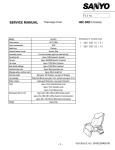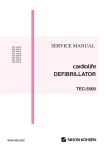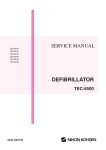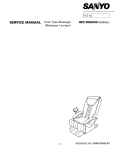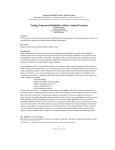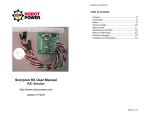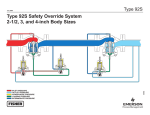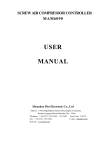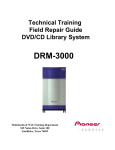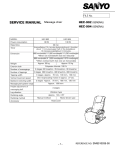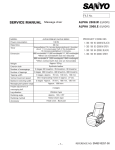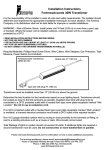Download SM6510406-00_041.09 MB
Transcript
FILE No. SERVICE MANUAL MODEL Power source Power consumption Rated time Personal sensor course Automatic course Kneading rate Massage chair HEC-DR21 (TAIWAN) HEC-DR21 PRODUCT CODE NO. AC 110 V 60Hz 165 W 1 - 383 206 51 ( K ) 1 - 383 206 52 ( H ) 30 minutes Recovery / Relax Four (neck / shoulders, upper torso, lower back, legs) Approx. 16,22,30 pulses/min. (3 speeds) Tap rate Tap range Back stretch settings Approx. 300,480,600 times/min. (3 positions) Approx. 70,100,130mm (3 positions) Approx. 70,100,130mm (3 positions) Vertical motion rate Approx. 30sec./up-and-down cycle Massage sphere vertical reach Approx. 635mm (straight line) Reclining angle Back: approx. 120-170 degrees, Leg: approx. 0-100 degrees Leg massage Rotating roller (Manual course: approx. 15 min., Automatic course: approx. 12 min.) Roller rotation Higher speed: 100 times/min., Lower speed: 70 times/min. Timer Approx. 13 min. (Automatic Sensor course) Approx. 12 min. (Automatic course) Approx. 15 min. (Manual course) Dimensions (W x D x H) Weight Approx. 670 x 1,000 x 1,050 mm (When footrest is stored) Approx. 670 x 1,550 x 550 mm (When footrest is in horizontal position) Approx. 670 x 1,700 x 550 mm (When footrest is fully opened) Approx. 55 kg - 1- REFERENCE NO. SM6510406-00 Block Diagrams HEC-DR21 (TAIWAN) Back rest massage unit Remote control Foot rest massage unit Control unit Body contour detection (coil) Top end position detection of back massage section (microswitch) Body contour detection Top end position detection Rotation detection of massaging motor (Hall IC IC-202) Massaging pulse detection Detection of massaging arm home position (Hall IC IC-201) Massaging home position detection Rotation detection of tapping motor (Hall IC IC-301) SW for entering signals for instructing actions and LED for displaying the status Back rest massage unit Tapping motor Tapping pulse detection Remote control operation and display Stiffness sensor section Detection of perspiration rate by electric resistance Detection of number of pulses by light Skin temperature detection by thermistor Detection of rotation and rotating direction of elevating motor (Hall IC CI-401/402) Control unit Perspiration rate detection Elevation motor Detection of number of pulses Skin temperature detection Reclining motor (Back rest) Detection of elevating motor rotation Top and bottom reclining end detection of backrest section (microswitch) Reclining (backrest) limit detection Top and bottom reclining end detection of footrest section (microswitch) Reclining (footrest) limit detection Load detection of leg massaging motor (CT1) Massaging motor Reclining motor (Foot rest) Foot rest massage unit Leg motor load detection - 2- Leg roller motor CNA801 - 3- Condenser (16 F) Motor (Elevation) Switch Switch Motor CNA701 15 CN603 Switch Switch Motor CN601 CN401 CN402 CN251 Printed board (Foot Rest) CN252 CN253 Printed board (UP/DOW Pulse) CN403 CN404 Motor (Leg Roller) Reclining Motor(Back Rest) CN602 Printed board (Control) Printed board (Indication) CNA702 12 CNA601 CN604 Reclining Motor(Leg Rest) Sensor B Printed board (Sensor B) CN951 Printed board (Sensor A) CN14 CN13 CN8 CN6 CN10 CN9 CN1 CN18 CN20 CN19 CN15 CN7 Printed board(Main) CN4 CN3 CN2 CN12 CN5 CN11 CN301 Limit Switch Printed board (Pulse) Reactor(Leg Roller) Reactor Reactor Printed board (Shape) CN502 CN202 CN203 Printed board (Relay) CN201 Fuse (250V 4A) Motor Motor CN503 CN501 Transfomer Shape Sensor Transfomer Switch Wiring Diagram HEC-DR21 (TAIWAN) Shape sensor Printed board (Pulse) Limit switch Switch(DOW) Reclining motor (Leg rest) Switch(UP) Switch(DOW) Switch(UP) Reclining motor (Back rest) Printed board (Shape) Printed board (Relay) -4Motor (Elevation) Printed board (UP/DOW pulse) Condenser Printed board (Main) Printed board (Foot rest) Transfomer Fuse Reclining motor (Back rest) Motor (Leg roller) Reactor Switch Reclining motor (Back rest) Motor (Massaging) Reactor Motor (Tapping) Reactor Circuit Diagram HEC-DR21 (TAIWAN) Printed board (Indication) - 5Printed board (Sensor B) Sensor B Printed board (Sensor A) Printed board (Control) Circuit Diagram HEC-DR21 (TAIWAN) Operation of Stiffness Detecting Sensor HEC-DR21 (TAIWAN) To the remote controller sensor section, three kinds of sensors (skin electric resistance, photo sensor, thermistor) are assembled, and measure three kinds of physiological amounts (perspiration, pulse, skin temperature). When stiff portions are subject to massage stimulus of detection massage, changes are observed in the perspiration rate, number of pulses, and skin temperature. These three kinds of displacements are measured. Perspiration Pulse Skin temperature sensor section If your body receives stimulus and feels “stiffness,” Use rollers for legs. Use massaging balls for neck/shoulder, back, and waste. Perspiration increases. Pulses accelerate. Skin temperature lowers. Stiffness feeling is judged by combinations of perspiration rate, number of pulses, and skin temperature and are classified into four stages (relax, normal, stiffness feeling, pains). 1. In the case of relax, perspiration rate tends to lower. 2. In the case of normal, change of each physiological amount is small. 3. In the case of stiffness feeling, perspiration rate and number of pulses tend to increase. 4. In the case of pains, perspiration rate greatly increases and number of pulses tends to increase. Stiffness feeling is indicated by three colors: green (relax), orange (normal), red (stiffness feeling/pains). Operation of Body Contour Sensor The body contour sensor judges the body contour (shoulder position) by changes of angles of massage arms. Sensors consist of coils and iron cores, detect displacement of reactance, and convert into angular changes. Iron core linked to arm. Arm angle that varies in accord with body curves is detected and human body build and shoulder position are judged. coil section Even if body position is deviated during massage, the shoulder position is automatically corrected. -6- Sensor-automated Massage HEC-DR21 (TAIWAN) Sensor-automated massage judges stiffness feeling by measuring changes of physiological amounts of perspiration, pulses, skin temperature during detection massage, displays the degree of stiffness feeling in three colors, and carries out massage suited for stiffness feeling. Method and action of sensor-automated massage 1. Place fingers at two places of sensor section of the remote controller. 2. Press "ON/OFF" operation button. 3. Choose "Relax" or "Recovery from fatigue" and press button. LED lamp of the course chosen is lighted red. Relax course: (Gently massages in such a manner as to relax the whole body.) Recovery from fatigue course: (Steadily massages with special emphasis placed on portions with stiffness feeling.) Press the button of the course to be chosen. Press the sensor section A with the forefinger. Lightly press the sensor section B with the thumb. 4. Detection massage begins (about 3 minutes). Neck/shoulder, back, waist, and legs are tapped, massaged, and tap-massaged, and stiffness feeling is judged in four stages and indicated in three colors (leg sections are massaged with rollers only). If fingers are released from sensor sections during detection massage, no accurate measurement can be made. When accurate judgment is unable to be made, indicator lamps for stiffness feeling judgment do not go on and standard massaging operation takes place. 5. Upon completion of detection massage, a buzzer comes on and massage of the course chosen takes place. 6. Based on stiffness feeling judged in four stages by detection massage, massage suited for stiffness feeling is carried out for about 10minutes by varying speed and time with respect to standard action of each course. When “Relax” course is chosen: Each massage at portions with stiffness feeling is carried out at slower speed and in shorter time. Each massage at relaxed portions is carried out at standard speed and in longer time. In the case of normal portions, each massage takes place at standard speed and time. When “Recovery from fatigue“ course is chosen: Each massage at portions with stiffness feeling is carried out at standard speed and in longer time. Each massage at relaxed portions is carried out at faster speed and in shorter time n the case of normal portions, each massage takes place at standard speed and time. If "Pains" judgment is obtained by detection massage, massage speed is decreased and time is also decreased for both courses. (When it is judged that the back aches, massage of the back is omitted.) If courses are changed after detection massage, massage is carried out from the very beginning of the course changed. - 7- Massage Motors HEC-DR21 (TAIWAN) 2 2 2, Massage motor 1 4 3 4, Leg massage motor 1, Tapping motor 3, Elevation motor Screw bar 1, Tapping motor roller This motor rotates to move the massage balls upward and downward alternately via the driving belt coupled to the motor. (The motor revolutions is adjustable in three steps so that the patting frequency can be changed over to approximately 360, 480 and 600 cycles/minute.) 2, Massage motor This motor rotates to move the massage balls crosswise via the driving belt and gear box coupled to the motor. (The motor revolutions is adjustable in three steps so that the massaging frequency can be changed over to approximately 20, 25 and 30 cycles/minute.) (When patting and stretching the backbone line, the massage ball position (ball moving range) can be changed over in three steps after starting the patting motor.) 3, Elevation motor This motor rotates to transmit its rotating torque to the threaded rod via the driving belt, whereby the massage unit is moved upward and downward. (This motor rotates clockwise and counterclockwise to thereby move the massage unit upward and downward.) Tapping-massaging You can enjoy the good comfort that you can not do by hand tapping-massage, by starting both the tapping motor and the massage motor simultaneously. I-shaped tapping - Z-shaped massaging Massaging same portion can be prevented by moving minutely the massage balls upward and downward by starting the elevation motor while running the tapping motor for tapping operation or the massage motor for massaging operation. 4, Leg massage motor The leg motor rotation is transmitted to the outside roller through gear box. Motor rotating speed is changed over between normal/reverse. In addition, the rotating speed is adjusted in two stages and changed over to about 100 or 70 revolutions/min. -8-








